英语专业-2001-级毕业论文情况一览表---副本---副本
- 格式:pdf
- 大小:345.85 KB
- 文档页数:52
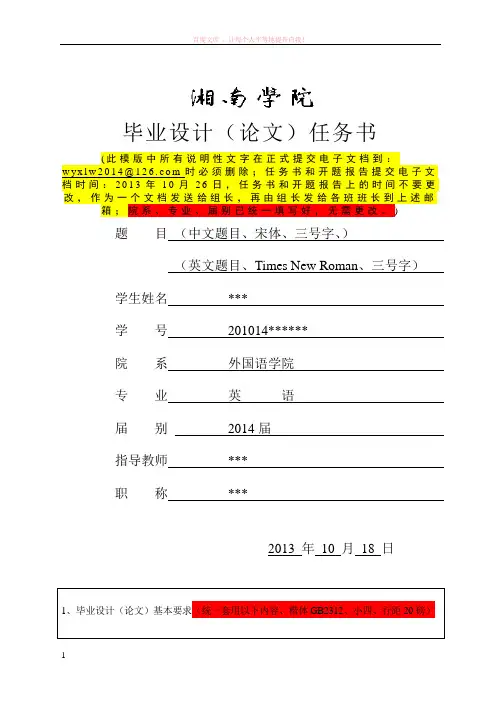
毕业设计(论文)任务书(此模版中所有说明性文字在正式提交电子文档到:w y x l w2014@126.c o m时必须删除;任务书和开题报告提交电子文档时间:2013年10月26日,任务书和开题报告上的时间不要更改,作为一个文档发送给组长,再由组长发给各班班长到上述邮箱;院系、专业、届别已统一填写好,无需更改。
)题目(中文题目、宋体、三号字、)(英文题目、Times New Roman、三号字)学生姓名***学号201014******院系外国语学院专业英语届别2014届指导教师***职称***2013 年10 月18 日1、毕业设计(论文)基本要求(统一套用以下内容、楷体GB2312、小四、行距20磅)(1) 该内容应理论联系实际,运用科学的研究方法对选题进行认真分析,力争立论正确,证据充分;(2) 引用别人的研究成果,一定要注明出处;(3) 篇幅要适当,5,000字左右,全英文写作;(4) 使用电脑录入和打印论文及其相关资料;(5) 运用本专业所学知识,在广泛阅读和自己选题相关的文献的基础上,写出自己的看法或对他人之观点发表自己的见解,须有一定的创新。
2、文献查阅指引(1.英文文献:Times New Roman、小四、行距20磅;中文文献:楷体_GB2312、小四号、行距20磅;2.英文文献在前,中文文献在后,排序原则是:无论中英文文献,皆以作者名字首字母在英文中的字母顺序排列,首字母相同的,以姓名第二字母的先后排序,依此类推;3.英文的著作文献必须用斜体;中文著作文献则不要斜体,但也不要加书名号;4.所有文献,特别是期刊文献必须标注出具体页码;5.所有文献都以实心句点结尾;英文和中文文献的作者名称后都是句点,英文文献中单词间要空格,中文则不要;6.文献序号排列在方括号中,一个文献另起一行时,第二行相对第一行右缩进4个字符,如有第三、四行则与第二行左对齐;特别提示:该处参考文献数目不能少于5个,必须要有:著作文献、期刊文献,其中至少必须有2条英文文献![1] Andre Lefevere. Translating Literature: Practice and Theory in a Comparative LiteratureContext[M]. Beijing: Foreign Language Teaching and Research Press, 2006.[2] Dunkling, Leslie Alan. The Guiness Book of Names[M]. London: GuinnessPublishing, 1991.[3] Peter Newmark. A Textbook of Translation[M]. Shanghai: Shanghai Foreign LanguageEducation Press, 2001.[4]卜爱会.浅析人名文化翻译[J].科技信息(学术研究),2007,(27):174.[5]包惠南.文化语境与语言翻译[M].北京: 中国对外翻译出版公司,2001.[6]黄向前.英汉文学作品的人名寓意及翻译[J].湖南科技学院学报,2005,(2):138-139.(说明:此处文献仅提供格式上的参考,每个人必须用自己的文献;此处的文献条目数须比开题报告中文献少2-3条)3、毕业设计(论文)进度要求(统一套用一下内容)(1) 选题,定题:2013年10月上旬;(2) 资料查询:2013年10月中旬至2013年11月中旬;(3) 任务书和开题报告:2013年10月中下旬;(4) 初稿:2013年11月底;(5) 第二稿:2014年2月下旬;(6) 第三稿:2014年4月中旬(7) 定稿:2014年5月上旬;(8) 答辩:2014年5月中旬毕业设计(论文)指导小组意见请按照本任务书对本科生毕业论文内容和格式的基本要求,认真查阅老师所提供的和自己选题相关的文献资料,根据外国语学院论文指导委员会安排的论文创作进度开始论文写作。
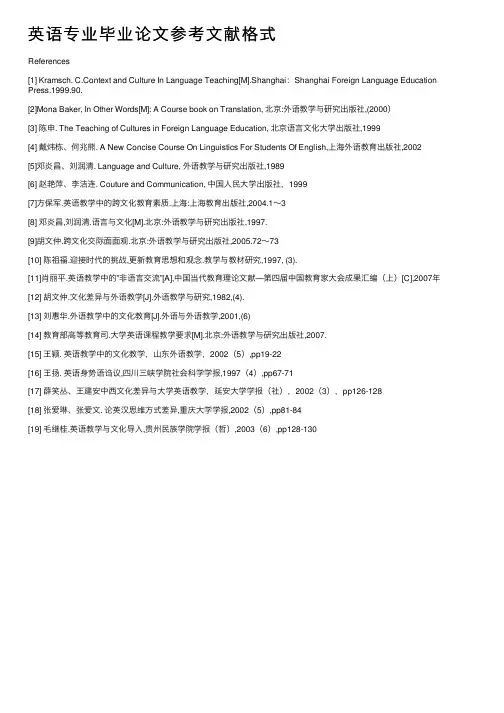
英语专业毕业论⽂参考⽂献格式References[1] Kramsch. C.Context and Culture In Language Teaching[M].Shanghai:Shanghai Foreign Language Education Press.1999.90.[2]Mona Baker, In Other Words[M]: A Course book on Translation, 北京:外语教学与研究出版社,(2000)[3] 陈申. The Teaching of Cultures in Foreign Language Education, 北京语⾔⽂化⼤学出版社,1999[4] 戴炜栋、何兆熊. A New Concise Course On Linguistics For Students Of English,上海外语教育出版社,2002[5]邓炎昌、刘润清. Language and Culture, 外语教学与研究出版社,1989[6] 赵艳萍、李洁连. Couture and Communication, 中国⼈民⼤学出版社,1999[7]⽅保军.英语教学中的跨⽂化教育素质.上海:上海教育出版社,2004.1~3[8] 邓炎昌,刘润清.语⾔与⽂化[M].北京:外语教学与研究出版社,1997.[9]胡⽂仲.跨⽂化交际⾯⾯观.北京:外语教学与研究出版社,2005.72~73[10] 陈祖福.迎接时代的挑战,更新教育思想和观念.教学与教材研究,1997, (3).[11]肖丽平.英语教学中的”⾮语⾔交流”[A],中国当代教育理论⽂献—第四届中国教育家⼤会成果汇编(上)[C],2007年[12] 胡⽂仲.⽂化差异与外语教学[J].外语教学与研究,1982,(4).[13] 刘惠华.外语教学中的⽂化教育[J].外语与外语教学,2001,(6)[14] 教育部⾼等教育司.⼤学英语课程教学要求[M].北京:外语教学与研究出版社,2007.[15] 王颖. 英语教学中的⽂化教学,⼭东外语教学,2002(5),pp19-22[16] 王扬. 英语⾝势语诌议,四川三峡学院社会科学学报,1997(4),pp67-71[17] 薛笑丛、王建安中西⽂化差异与⼤学英语教学,延安⼤学学报(社),2002(3),pp126-128[18] 张爱琳、张爱⽂. 论英汉思维⽅式差异,重庆⼤学学报,2002(5),pp81-84[19] ⽑继桂.英语教学与⽂化导⼊,贵州民族学院学报(哲),2003(6),pp128-130。
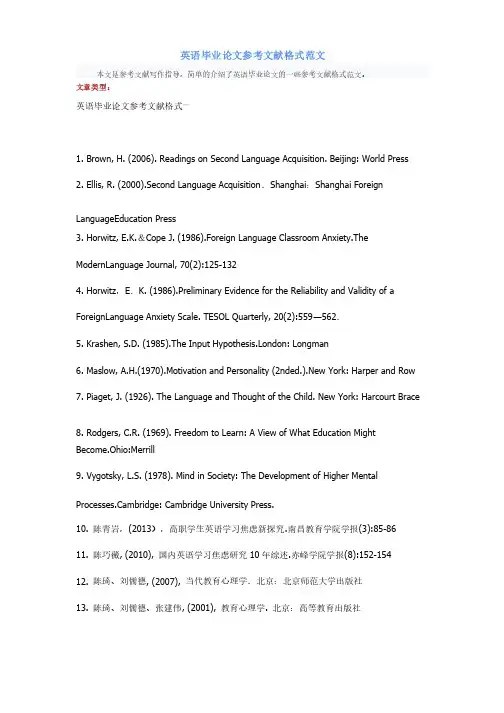
英语毕业论文参考文献格式范文本文是参考文献写作指导,简单的介绍了英语毕业论文的一些参考文献格式范文。
文章类型:英语毕业论文参考文献格式一英语毕业论文参考文献格式一1. Brown, H. (2006). Readings on Second Language Acquisition. Beijing: World Press2. Ellis, R. (2000).Second Language Acquisition .Shanghai :Shanghai Foreign LanguageEducation Press3. Horwitz, E.K.&Cope J. (1986).Foreign Language Classroom Anxiety.TheModernLanguage Journal, 70(2):125-1324. Horwitz ,E .K. (1986).Preliminary Evidence for the Reliability and Validity of a ForeignLanguage Anxiety Scale. TESOL Quarterly, 20(2):559ForeignLanguage Anxiety Scale. TESOL Quarterly, 20(2):559——562.5. Krashen, S.D. (1985).The Input Hypothesis.London: Longman6. Maslow, A.H.(1970).Motivation and Personality (2nded.).New York: Harper and Row7. Piaget, J. (1926). The Language and Thought of the Child. New York: Harcourt Brace8. Rodgers, C.R. (1969). Freedom to Learn: A View of What Education MightBecome.Ohio:Merrill9. Vygotsky, L.S. (1978). Mind in Society: The Development of Higher MentalProcesses.Cambridge: Cambridge University Press.10. 陈青岩,(2013),高职学生英语学习焦虑新探究.南昌教育学院学报(3):85-8611. 陈巧薇, (2010), 国内英语学习焦虑研究10年综述.赤峰学院学报(8):152-15412. 陈琦、刘儒德, (2007), 当代教育心理学.北京:北京师范大学出版社当代教育心理学.北京:北京师范大学出版社13. 陈琦、刘儒德、张建伟, (2001), 教育心理学. 北京:高等教育出版社北京:高等教育出版社14. 车文博, (2003), 人本主义心理学. 杭州:浙江教育出版社杭州:浙江教育出版社15. 郭永玉、王伟, (2007), 心理学导引.武汉:华中师范大学出版社心理学导引.武汉:华中师范大学出版社16. 贾冠杰, (2006), 二语习得论. 南京:东南大学出版社南京:东南大学出版社17. 贾冠杰,(2010),英语教学基础理论. 上海:上海外语教育出版上海:上海外语教育出版18. 刘文娟, (2010), 高职非英语专业学生英语学习焦虑的调查及其对策.济南职业学院学报(4):104-10619. 廖晓燕,桑龙扬, (2010), 高职院校学生英语学习焦虑降低的对策.九江学院学报(1):113-11520. 闵芬, (2008), A Case Study of Correlation between English Learners’ Anxiety andTheir Oral Performance in the Language Classroom, 中国知网中国优秀硕士学位论文全文数据库. 东华大学硕士学位论文东华大学硕士学位论文21. 王寅,(2007), 认知语言学. 上海: 上海外语教学研究出版社上海外语教学研究出版社22. 西格蒙德·弗洛伊德,林尘译, (2011), 自我与本我。


英语专业毕业论文翻译类论文精选文档TTMS system office room 【TTMS16H-TTMS2A-TTMS8Q8-毕业论文(设计)Title:The Application of the Iconicity to the Translation ofChinese Poetry题目:象似性在中国诗歌翻译中的应用学生姓名孔令霞学号 BC09150201指导教师祁晓菲助教年级 2009级英语本科(翻译方向)二班专业英语系别外国语言文学系黑龙江外国语学院本科生毕业论文(设计)任务书摘要索绪尔提出的语言符号任意性,近些年不断受到质疑,来自语言象似性的研究是最大的挑战。
语言象似性理论是针对语言任意性理论提出来的,并在不断发展。
象似性是当今认知语言学研究中的一个重要课题,是指语言符号的能指与所指之间的自然联系。
本文以中国诗歌英译为例,探讨象似性在中国诗歌翻译中的应用,从以下几个部分阐述:(1)象似性的发展;(2)象似性的定义及分类;(3)中国诗歌翻译的标准;(4)象似性在中国诗歌翻译中的应用,主要从以下几个方面论述:声音象似、顺序象似、数量象似、对称象似方面。
通过以上几个方面的探究,探讨了中国诗歌翻译中象似性原则的重大作用,在诗歌翻译过程中有助于得到“形神皆似”和“意美、音美、形美”的理想翻译效果。
关键词:象似性;诗歌;翻译AbstractThe arbitrariness theory of language signs proposed by Saussure is severely challenged by the study of language iconicity in recent years. The theory of iconicity is put forward in contrast to that of arbitrariness and has been developing gradually. Iconicity, which is an important subject in the research of cognitive linguistics, refers to a natural resemblance or analogy between the form of a sign and the object or concept. This thesis mainly discusses the application of the iconicity to the translation of Chinese poetry. The paper is better described from the following parts: (1) The development of the iconicity; (2) The definition and classification of the iconicity; (3) The standards of the translation to Chinese poetry; (4) The application of the iconicity to the translation of Chinese poetry, mainly discussed from the following aspects: sound iconicity, order iconicity, quantity iconicity, and symmetrical iconicity. Through in-depth discussion of the above aspects, this paper could come to the conclusion that the iconicity is very important in the translation of poetry. It is conductive to reach the ideal effect of “the similarity of form and spirit” and “the three beauties”.Key words: the iconicity; poetry; translation黑龙江外国语学院2013届毕业论文Contents摘要 (i)Abstract.. (ii)Chapter 1 Introduction ................ . (1)Chapter 2 An Overview of the Iconicity ............................ .. (3)2.1 The Iconicity and the Arbitrariness (3)2.2 Definition of the Iconicity (4)2.3 Classification of the Iconicity (5)Chapter 3The Standards of the Translation to Chinese Poetry (6)3.1 The Similarity of Form and Spirit......................... .. (6)3.2 The Three Beauties.............. . (7)3.3 The Principle of theI conicity….............................…………………….....……...7Chapter 4 The Application of the Iconicity to the Translation of Chinese Poetry ............................................... (8)4.1 The Application of the Iconicity to the Translation of ChinesePoetry on the Phonological Level (9)4.1.1 Sound Iconicity and its Translation on Chinese Poetry......................................... . (9)4.2 The Application of the Iconicity to the Translation of Chinese Poetry on theTextualLevel (9)4.2.1 Order Iconicity and Its Translation on Chinese Poetry (9)4.2.2 Quantity Iconicity and Its Translation on ChinesePoetry (12)4.2.3 Symmetrical Iconicity and Its Translation on Chinese Poetry (15)Chapter 5 Conclusion (17)Bibliography.........................................................................................18 Acknowledgements.. (19)The Application of the Iconicity to the Translation of ChinesePoetryChapter 1 IntroductionThe ancients left a lot of poetry in China which reflects the broad and profound Chinese literature. With the development of Chinese literature, more and more scholars have been widely studied about the translation of Chinese poetry. Among the standards of the translation to Chinese poetry, the iconicity has aroused more and more concern. practicalism and semiotics. Since then this theme has been discussed and studied by many famous researches like Jakobson, Haiman, and so on. Iconicity is one of thehotly-discussed issues at present in the linguistic and semiotic field. The theory oficon icity is a great challenge to “Saussurean theory of arbitrariness” and a forceful complement as well. Iconicity in language falls into the category of cognitive linguistics,which is regarded as an essential part of cognitive linguistics. Iconicity is not only a challenge but also a complement to Saussure’s arbitrariness of linguistic sign. The discussion over arbitrariness and iconicity is a hot topic in the field of language research, which is actually a problem about the relationship of the signifier and the signified. In fact, the study of iconicity has been carried out in recent years, Many philosophers, semioticians and linguists have been concemed with such phenomenon in language for a long time. Iconicity can be found not only in natural language, but alsoin literary language, especially in poetry, which is said to have the richest presence of iconicity in all literary genres, because poetry allows the most complex and innovative use of language on the typographical level(such as special use of fonts and spacing), on the sound level (such as sound symbolism, metre and rhyme), on the morphological and syntactic level (such as changes in regular word order and distancing), and on the textual level.This thesis attempts to analyze Chinese poetry and its translation from a more integrated and original perspective, an iconic perspective. Much Chinese poetry can be translated from the perspective of iconicity. The iconicity is an important feature of poetry and should be reproduced in its translation. In the application of the principle oficonicity to the translation of Chinese poetry, it is advisable to grasp the expressive features of iconic discourse in the source version and properly present them in the target version. This article through the following aspects: sound iconicity, order iconicity, quantity iconicity, symmetrical iconicity so as to realize the re-creating in the form as well as in the spirit.Chapter 2 An Overview of the IconicityThe theory of iconicity is regarded as a gre at challenge to Saussure’s arbitrariness of linguistic sign. the founder of American practicalism and semiotics. According to Peirce and Haiman’s classification of iconic signs, this paper gets six subclasses of iconicity: the sound iconicity, the distance iconicity, the order iconicity, the quantity iconicity, the graph iconicity and the symmetry iconicity.2.1 The Iconicity and the ArbitrarinessThe arbitrariness theory of language signs proposed by Saussure is severely challenged by the study of language iconicity in recent years. The view that the language sign is arbitrary is the core of Saussure’s linguistic theory. Saussure found the nature of language symbol but he left the link unexplained between the signifier and the signified. The theory of iconicity is put forward in contrast to that of arbitrariness and has been developing gradually. Iconicity, which is an important subject in the research of cognitive linguistics, refers to a natural resemblance or analogy between the form of a sign and the object or concept.Iconicity has been discussed hotly at present in the linguistic and semiotic field. The theory of iconicity is put forward in contrast to that of arbitrariness and has been developing gradually. Meanwhile, it is a forceful complement to Sau ssure’s arbitrariness as well. Iconicity in language means that the form of the word or sign conveys the meaning of the word or sign. The theory of iconicity is regarded as a great challenge to Saussure’s arbitrariness of linguistic sign. The study of iconicity has been carried out in recent years.2.2 Definition of Iconicitythe founder of American practicalism and semiotics. Since then this theme has been discussed and studied by many famous researchers like Haiman, Givon, and so on. The following are some of the representative definitions of iconicity.Haiman characterizes iconicity as a set of “signs whose meaning in some crucial way resembles their form”. He also claims that “…linguistic forms are frequently the way is because, like diagrams, they resemble the conceptual structures they are intended to convey”. The relationship between form and meaning is to a considerable extent motivated. Cognitive linguists maintain that linguistic structure is a reflection of cognitive or experiential structure. Newmeyer argues that iconicity “embodies the idea that the form, length, complexity, or interrelationship of elements in a linguistic representation reflects of communicative strategy that the representation encodes.”Givon claims that any non-arbitrary relation in language qualifies an iconic relation.Therefore, some scholars usually conclude that iconicity is the similarity between the signifier and the signified. Language iconicity refers to the phenomenon of imitation between the sound, meaning, and form of language and what they signify in the real world. From the above-mentioned definitions, this paper can find that there is still no fixed definition of iconicity so far. Although researchers have made many attempts, none of their definitions is so perfect as to explain all the phenomena in language, and to some extent, its application is dependent on the subjectivity of the researchers and scholars themselves.2.3 The Classification of the IconicityOutside world is the source of sign's meaning, according to Peirce, signs can be placed in to three classes. Peirce identifies three types of signs: icon, index and symbol. The three kinds of signs are different from each other in terms of the degree of arbitrariness. He also further divides icons into three types: images, diagrams and metaphors, which differ from each other according to the similarity between the sign and its objects. In accordance with these he concludes three types of iconicity: imagic iconicity, Diagrammatic iconicity and Metaphorical iconicity.Haiman further develops Peirce’s theory and regards diagrammatic iconicity as “a systematic arrangement of signs, none of which necessarily resembles its referent, but whose relationships to each other mirror the relationships of their referents.”Haiman further classifies diagrammatic icon into two types: isomorphism and motivation.According to Peirce and Haiman’s classification of iconic signs, this paper gets six subclasses of iconicity: the sound iconicity, the distance iconicity, the order iconicity, the quantity iconicity, the graph iconicity and the symmetry iconicity. The iconicity can be found on the phonological level, lexical level, syntactic level and textual level. This thesis will analyze the four iconicity principles of them.Chapter 3 The Standards of the Translation to the Chinese Poetry There are many standards of the translation to the Chinese poetry, and among them these three standards are famous. “The similarity of form and spirit” or “the beaut y of sense the beauty of sound the beauty of form” are the ideal standers and goals of translation, but the iconicity is the most important and effective rhetorical device in poetry creation.3.1 The Similarity of Form and SpiritIn the case of literary text, the most optimal state is “the similarity of form and spirit”. However, it is very hard to both express the verve of the original texts and represent the form of the original texts in the translation practice. Sometimes, it is impossible to get the translation effects with “both form and content integrated” And for exactly that reason, Ma o dun propose ‘spirit likeness’ and Fu lei stand s for “spirit is much more important than form” if you c an’t have your cake and eat it, you should give up the “shape” and leave the “spirit”. Compared to other literary form, poetry has its unique features on the sound, word, sentence, text structure of its organization and selection. Poetry emphasized on the outside world imitation, through mimicking the outside world of sound, form and structure to realize its stylistic effects.3.2 The Three BeautiesProfessor Xu Yuanchong proposes that “Three beauties” are the highest standards for poems translation. The “Three beauties” are the beauty of sense, the beauty of soundand the beauty of form. The “Three beauties” are an organic whole; none of them can be ignored.Its basic meaning is: Poetry translation in meaning, sound, form structure these several levels, should use the corresponding and appropriate target language to convey vividly the poetic charm. That will give us the beautiful enjoyment of art in vision, feeling and hearing.Professor Xu Yuanchong stressed that you should put your hand to the meaning, sound and rhymes these three aspects to translate poetry successfully. Cognitively, the principle of “three beauties” is consistent with the iconicit y of poetry. The “three beauties” and the “the similarity of form and spirit” are consistent. “B eauty of sound” “beauty of form” correlate “the similarity of form”; “beauty of sense” correlates “the similarity of spirit”.3.3 The Principle of the IconicityAs “the similarity of form and spirit” or “the beauty of sense the beauty of sound the beauty of form” are the ideal standers and goals of translation, but how to attend it. Lu Weizhong thinks people should adopt the viewpoint of iconicity and throughout the translation of form especially form of extra meaning to achieve the ideal translation effect of “similarity of form and spirit”Among the types of literature, poetry’s iconicity is the most prominent iconicity. Iconicity is the most important and effective rhetorical device in poetry creation. So, pay attention to recognize and analyze the applying of iconicity technique in the original poems when to translate the poetry that can be able to achieve the ideal goal of “similarity of form and spirit” The iconicity now prevails in the literary works, which is a fact can not be negated. From the perspective of sign iconicity, scholars consider iconicity into literature, which reflects the real life in various ways.Iconicity is ubiquitous in literary language. It is emphasized as one of the constraints in poetic text structure.Chapter 4The Application of the Iconicity to the Translation ofChinese PoetryThis chapter is about the application of the iconicity to the translation of Chinese poetry. According to Peirce and Haiman’s classification of iconic signs, this paper gets six subclasses of iconicity: the sound iconicity, the distance iconicity, the order iconicity, the quantity iconicity, the graph iconicity and Symmetry iconicity. The iconicity can be found on the phonological, lexical, Syntactic and textual level. This chapter will analyze the four iconicity principles in poetry just from the phonological and textual level with examples.4.1 The Application of the Iconicity to the Translation of Chinese Poetry on the Phonological LevelThis part is about sound iconicity and its translation on Chinese poetry. Sound iconicity usually includes onomatopoeia and sound symbolism, which belong to the category of imagic iconicity.4.1.1 Sound Iconicity and Its Translation on Chinese PoetrySound iconicity usually includes onomatopoeia and sound symbolism, which belong to the category of imagic iconicity. The purpose of sound iconicity can not only make the linguistic forms directly or indirectly imitate the sound of the objective world, but reinforce the conveyance of the poetic mood.Now let’s come to Li Qingzhao’s poem:梧桐更兼细雨,到黄昏,点点滴滴。
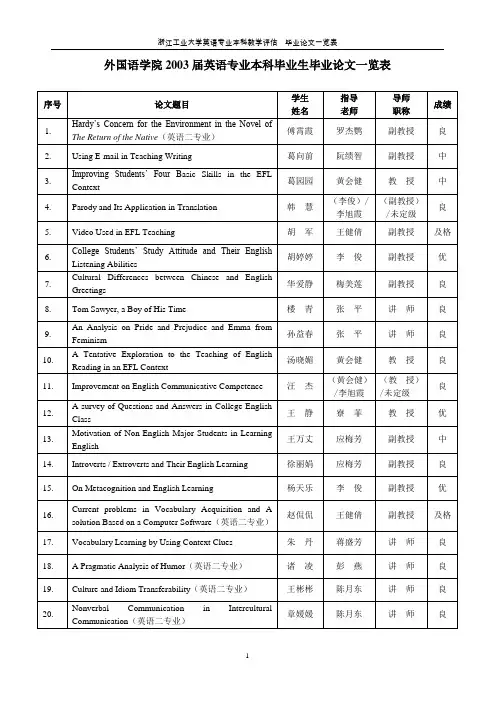
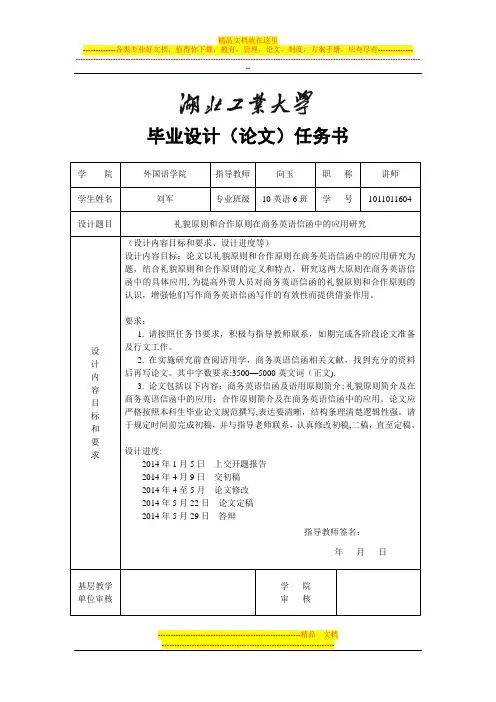
毕业设计(论文)任务书学院外国语学院指导教师向玉职称讲师学生姓名刘军专业班级10英语6班学号1011011604 设计题目礼貌原则和合作原则在商务英语信函中的应用研究设计内容目标和要求(设计内容目标和要求、设计进度等)设计内容目标:论文以礼貌原则和合作原则在商务英语信函中的应用研究为题,结合礼貌原则和合作原则的定义和特点,研究这两大原则在商务英语信函中的具体应用,为提高外贸人员对商务英语信函的礼貌原则和合作原则的认识,增强他们写作商务英语信函写作的有效性而提供借鉴作用。
要求:1. 请按照任务书要求,积极与指导教师联系,如期完成各阶段论文准备及行文工作。
2. 在实施研究前查阅语用学,商务英语信函相关文献,找到充分的资料后再写论文。
其中字数要求:3500—5000英文词(正文).3. 论文包括以下内容:商务英语信函及语用原则简介;礼貌原则简介及在商务英语信函中的应用;合作原则简介及在商务英语信函中的应用。
论文应严格按照本科生毕业论文规范撰写,表达要清晰,结构条理清楚逻辑性强。
请于规定时间前完成初稿,并与指导老师联系,认真修改初稿,二稿,直至定稿。
设计进度:2014年1月5日上交开题报告2014年4月9日交初稿2014年4至5月论文修改2014年5月22日论文定稿2014年5月29日答辩指导教师签名:年月日基层教学单位审核学院审核此表由指导教师填写学院审核毕业设计(论文)学生开题报告课题名称礼貌原则和合作原则在商务英语信函中的应用研究课题来源自选课题类型BY 指导教师向玉学生姓名刘军学号1011011604 专业班级10英语6班本课题的研究现状、研究目的及意义研究现状:随着全球经济一体化进程的加速,商务英语信函在国际贸易发展中发挥着日益重要的作用。
商务英语信函引起了越来越多的国内外学者关注和研究,其领域涉及翻译、词汇学、语义学及语用学.国内的,如:吴金凤的《商务英语信函的特点及翻译》;黄雪芳的《商务英语信函的词汇特征分析》;武瑞的《商务英语信函中的语用策略研究》。
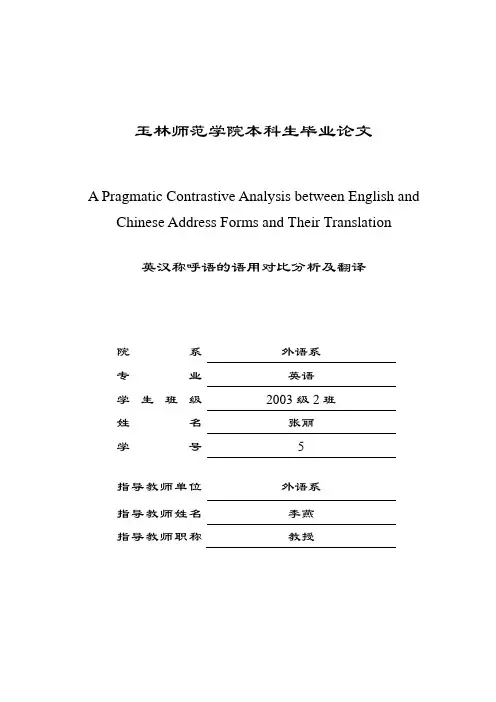
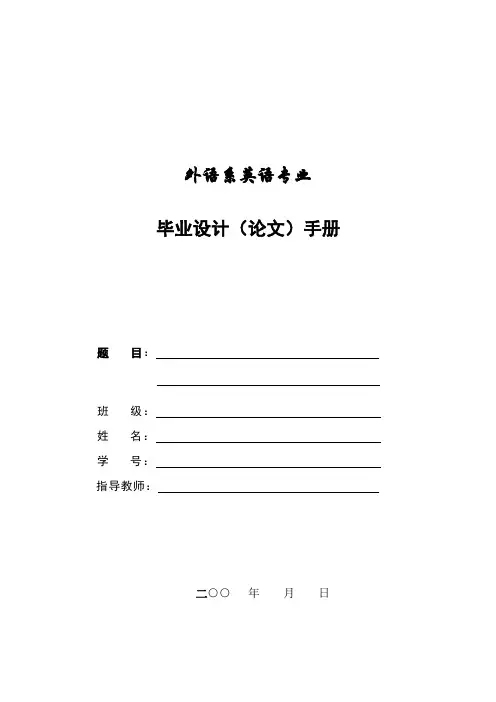
外语系英语专业毕业设计(论文)手册题目:班级:姓名:学号:指导教师:二○○年月日目录1. 英语专业毕业论文工作管理细则 (3)2. 英语专业学位论文撰写规范 (9)3.英语专业毕业论文阶段工作安排 (11)4. 毕业论文考勤和平时成绩登记表 (12)5. 阶段考核记录 (13)6. 立题申报表 (15)7. 成绩评定表(指导教师用) (16)8. 成绩评定表(评阅教师用) (17)9. 答辩记录 (18)10.成绩评定表(答辩和总评) (20)附录:英语专业毕业论文撰写示例西安建筑科技大学英语专业本科生毕业论文工作管理细则为规范英语专业本科生毕业论文管理工作,提高毕业论文的质量,特依据西建大教字(2009)002号文件“西安建筑科技大学本科生毕业设计(论文)工作管理办法”制定本管理细则。
一、毕业论文的目的通过毕业论文写作,综合应用和深化所学专业理论知识和专业技能,培养学生发现、分析和解决问题的能力,并通过论文写作考察学生的语言水平及综合能力使学生在知识、能力和素质方面达到下列要求:1.知识要求学生在毕业论文写作过程中,能够综合应用所学语言及理论知识和基本技能,分析解决相关问题。
通过学习、研究与实践,深化理论、拓宽知识、延伸专业技能。
2.能力要求学生应学会根据毕业论文的要求,进行调查研究,收集与处理有关的资料,确定论文选题;具有中、英文文献阅读及应用能力;掌握本专业学术论文的格式要求、理论研究的基本方法和程序;具有围绕专题进行分析、论证和用英语撰写论文的能力;具有综合运用、扩展语言知识和专业知识的能力;具有相应的书面和口头语言表达能力。
3.素质方面通过毕业论文写作,使学生树立正确的研究思想,培养学生严肃认真的科学态度和踏实严谨的科学作风和敬业精神,同时应根据毕业论文要求,了解外语学科的最新发展,在毕业论文中加以运用,力图有所创新。
二、毕业论文选题1.题目类型本专业毕业论文题目类型为研究类。
毕业论文的题目应确切反映毕业论文的核心内容,避免采用宽泛、笼统的题目;题目字数不超过25字为宜。
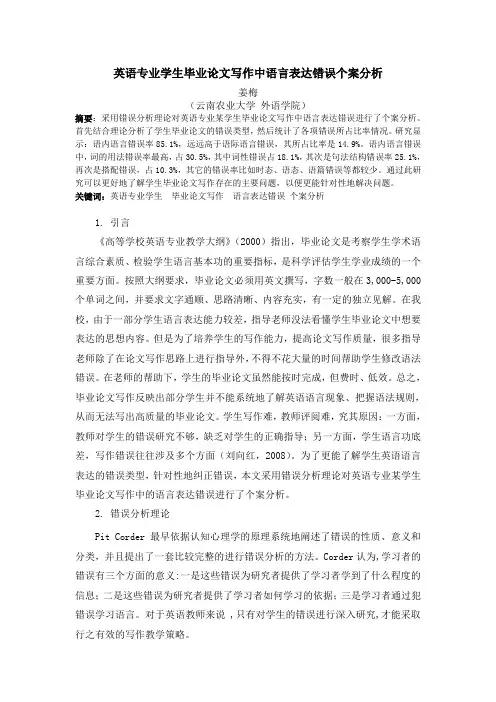
英语专业学生毕业论文写作中语言表达错误个案分析姜梅(云南农业大学外语学院)摘要:采用错误分析理论对英语专业某学生毕业论文写作中语言表达错误进行了个案分析。
首先结合理论分析了学生毕业论文的错误类型,然后统计了各项错误所占比率情况。
研究显示:语内语言错误率85.1%,远远高于语际语言错误,其所占比率是14.9%。
语内语言错误中,词的用法错误率最高,占30.5%,其中词性错误占18.1%,其次是句法结构错误率25.1%,再次是搭配错误,占10.3%,其它的错误率比如时态、语态、语篇错误等都较少。
通过此研究可以更好地了解学生毕业论文写作存在的主要问题,以便更能针对性地解决问题。
关键词:英语专业学生毕业论文写作语言表达错误个案分析1. 引言《高等学校英语专业教学大纲》(2000)指出,毕业论文是考察学生学术语言综合素质、检验学生语言基本功的重要指标,是科学评估学生学业成绩的一个重要方面。
按照大纲要求,毕业论文必须用英文撰写,字数一般在3,000-5,000个单词之间,并要求文字通顺、思路清晰、内容充实,有一定的独立见解。
在我校,由于一部分学生语言表达能力较差,指导老师没法看懂学生毕业论文中想要表达的思想内容。
但是为了培养学生的写作能力,提高论文写作质量,很多指导老师除了在论文写作思路上进行指导外,不得不花大量的时间帮助学生修改语法错误。
在老师的帮助下,学生的毕业论文虽然能按时完成,但费时、低效。
总之,毕业论文写作反映出部分学生并不能系统地了解英语语言现象、把握语法规则,从而无法写出高质量的毕业论文。
学生写作难,教师评阅难,究其原因:一方面,教师对学生的错误研究不够,缺乏对学生的正确指导;另一方面,学生语言功底差,写作错误往往涉及多个方面(刘向红,2008)。
为了更能了解学生英语语言表达的错误类型,针对性地纠正错误,本文采用错误分析理论对英语专业某学生毕业论文写作中的语言表达错误进行了个案分析。
2. 错误分析理论Pit Corder 最早依据认知心理学的原理系统地阐述了错误的性质、意义和分类,并且提出了一套比较完整的进行错误分析的方法。

矿产资源开发利用方案编写内容要求及审查大纲
矿产资源开发利用方案编写内容要求及《矿产资源开发利用方案》审查大纲一、概述
㈠矿区位置、隶属关系和企业性质。
如为改扩建矿山, 应说明矿山现状、
特点及存在的主要问题。
㈡编制依据
(1简述项目前期工作进展情况及与有关方面对项目的意向性协议情况。
(2 列出开发利用方案编制所依据的主要基础性资料的名称。
如经储量管理部门认定的矿区地质勘探报告、选矿试验报告、加工利用试验报告、工程地质初评资料、矿区水文资料和供水资料等。
对改、扩建矿山应有生产实际资料, 如矿山总平面现状图、矿床开拓系统图、采场现状图和主要采选设备清单等。
二、矿产品需求现状和预测
㈠该矿产在国内需求情况和市场供应情况
1、矿产品现状及加工利用趋向。
2、国内近、远期的需求量及主要销向预测。
㈡产品价格分析
1、国内矿产品价格现状。
2、矿产品价格稳定性及变化趋势。
三、矿产资源概况
㈠矿区总体概况
1、矿区总体规划情况。
2、矿区矿产资源概况。
3、该设计与矿区总体开发的关系。
㈡该设计项目的资源概况
1、矿床地质及构造特征。
2、矿床开采技术条件及水文地质条件。
探微本科翻译教学下的翻译实践练习论文关键词翻译教学实践练习论文摘要翻译实践是翻译研究过程中不可或缺的一部分。
只有通过大量的翻译实践,翻译能力才能够得到有效的提高。
如果离开了翻译实践,那么所有的翻译理论和翻译技巧都将只是纸上谈兵,而且翻译教学的目标也将无法实现。
一、合理分配各类文体的翻译练习所占的比例在针对北京近15所高校的调查中,笔者了解到:在英语专业本科阶段,教师指导下的翻译实践练习80%以上是关于文学领域的描述及叙述文体,而对其它文体的翻译练习却涉及较少。
然而,事实上,英语专业本科生毕业后,除了会在外国语言文学学科领域进行研究或教学工作,多半是在外事、教育、经贸、文化、科技、军事等部门从事翻译、教学、管理、研究等相关工作。
因此,学生除了要在翻译课上学习描述及叙述文体的用法特征之外,更应该接触的是与日后工作息息相关的文体类型,如公文文体、一般应用文体等等。
首先,我们来探讨一下文体的类别。
刘宓庆根据翻译工作的实际情况,在《文体与翻译》一书中概括出六种文体,即:新闻报刊文体、论述文体、公文文体、描述及叙述文体、科技文体及应用文体。
这六种文体基本上已经涵盖了全部的交际活动。
然而,随着法律的不断完善和法治社会的逐步建立,法律文体也日益引起学术界的普遍关注。
至此,我们可以说学术界和翻译界普遍认可的大致共有这七类文体。
其次,我们再来看一下文体与翻译之间的联系。
刘宓庆曾在《文体与翻译》一书中指出:文体与翻译的密切关系已经日益被翻译界所认识。
不论是英语还是汉语,都存在着不同的文体类别。
译者必须深谙英汉两种语言各类文体的特殊用法和特征,才能在英汉互译中尽可能做到使译文的文体和原文的文体相一致,以及使译文作者与原文作者的个人风格相一致。
文体与翻译的关系如此密切。
因此,在翻译的过程中,首先要认真的分析原文的文体特征,再思考如何能在译文中用相应的文体来表达,以求达到译文风格与原文风格相一致的效果。
最后,在英语专业本科的翻译教学中,又该如何分配各种文体的翻译练习所占的比例呢?由于本科阶段翻译教学的学时数限制,合理的安排好各种文体的翻译练习所占的比例显得至关重要,否则很可能顾此失彼、得不偿失。